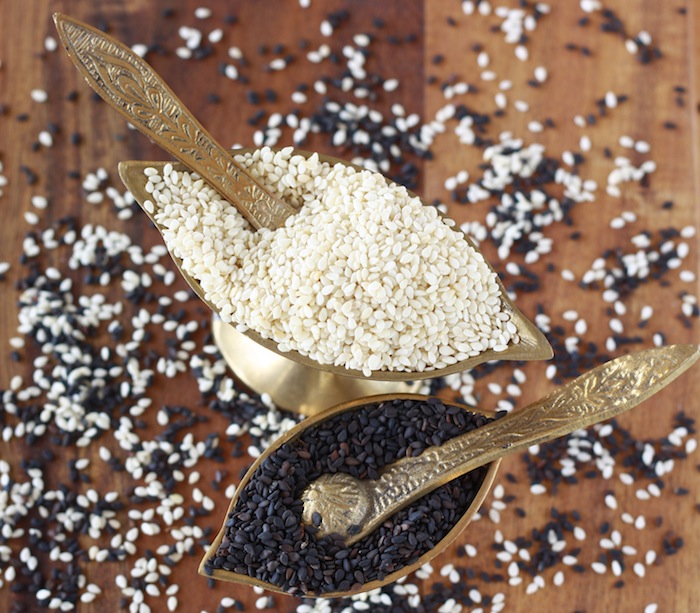|
I am really lazy and got busier than I thought today so instead of writing something up I plagiarized wikipedia. Sesame seed is a common ingredient in various cuisines. It is used whole in cooking for its rich, nutty flavour. Sesame seeds are sometimes added to breads, including bagels and the tops of hamburger buns. Sesame seeds may be baked into crackers, often in the form of sticks. In Sicily and France, the seeds are eaten on bread (ficelle sésame, sesame thread). In Greece, the seeds are also used in cakes. Fast-food restaurants use buns with tops sprinkled with sesame seeds. About 75% of Mexico's sesame crop is purchased by McDonald's for use in their sesame seed buns worldwide. In Asia, sesame seeds are sprinkled onto some sushi-style foods. In Japan, whole seeds are found in many salads and baked snacks, and tan and black sesame seed varieties are roasted and used to make the flavouring gomashio. East Asian cuisines, like Chinese cuisine, use sesame seeds and oil in some dishes, such as dim sum, sesame seed balls (Chinese: 麻 糰; pinyin: mátuǎn or 煎堆; Cantonese: jin deui), and the Vietnamese bánh rán. Sesame flavour (through oil and roasted or raw seeds) is also very popular in Korean cuisine, used to marinate meat and vegetables. Chefs in tempura restaurants blend sesame and cottonseed oil for deep-frying. Sesame, or simsim as it is known in East Africa, is used in African cuisine. In Togo, the seeds are a main soup ingredient and in the Democratic Republic of the Congo and in the north of Angola, wangila is a delicious dish of ground sesame, often served with smoked fish or lobster. Sesame seeds and oil are used extensively in India. In most parts of the country, sesame seeds mixed with heated jaggery, sugar, or palm sugar is made into balls and bars similar to peanut brittle or nut clusters and eaten as snacks. In Manipur, black sesame is used in the preparation of thoiding and in singju (a kind of salad). Thoiding is prepared with ginger and chili and vegetables are used in the spicy singu dish. In Assam, black sesame seeds are used to make til pitha and tilor laru (sesame seed balls) during bihu. In Punjab and Tamil Nadu, a sweet ball called pinni (پنی) in Urdu and ell urundai in Tamil, ellunda (എള്ളുണ്ട) in Malayalam, yellunde (sesame ball, usually in jaggery) in Kannada and tilgul in Marathi, is made of its seeds mixed with sugar. It is eaten in various forms during the festival of Makar Sankranti. Also in Tamil Nadu, sesame oil used extensively in their cuisine, milagai podi, a ground powder made of sesame and dry chili is used to enhance flavor, and is consumed along with other traditional foods such as idli. In Tamil Nadu and Andhra Pradesh, sesame oil is used as a preservative, as well as to temper the heat of their spicy foods, pickles, and condiments. Sesame seed cookies and wafers, both sweet and savory, are popular in places such as Charleston, South Carolina. Sesame seeds, also called benne, are believed to have been brought into 17th-century colonial America by West African slaves. Since then, they have become part of various American cuisines. In Caribbean cuisine, sugar and white sesame seeds are combined into a bar resembling peanut brittle and sold in stores and street corners. Sesame is a popular and essential ingredient in many Middle Eastern cuisines. Sesame seeds are made into a paste called tahini (used in various ways, including hummus bi tahini) and the Middle Eastern confection halvah. Ground and processed, the seed is also used in sweet confections. In South Asia, Middle East, and East Asian cuisines, popular confectionery are made from sesame mixed with honey or syrup and roasted into a sesame candy. In Japanese cuisine goma-dofu (胡麻豆腐) is made from sesame paste (tahini) and starch. Mexican cuisine refers to sesame seeds as ajonjolí. It is mainly used as a sauce additive, such as mole or adobo. It is often also used to sprinkle over artisan breads and baked in traditional form to coat the smooth dough, especially on whole-wheat flatbreads or artisan nutrition bars, such as alegrías. In Sicilian cuisine, what are commonly called "Italian sesame seed cookies" are known as giuggiuleni . A giuggiulena usually refers to a cookie, while a giurgiulena usually refers to a nougat-like candy, often made as a Christmas food. Both are alternative spellings for "sesame seed" in the Sicilian language. Sesame oil is sometimes used as a cooking oil in different parts of the world, though different forms have different characteristics for high-temperature frying. The "toasted" form of the oil (as distinguished from the "cold-pressed" form) has a distinctive pleasant aroma and taste, and is used as table condiment in some regions, especially in East Asia. Toasted sesame oil is also added to flavor soups and other hot dishes, usually just before serving, to avoid dissipating the volatile scents too rapidly. Although sesame leaves are edible as a leaf vegetable, recipes for Korean cuisine calling for "sesame leaves" are often a mistranslation, and really mean perilla.  Welcome to ICSA Sesame! Here are the rules: You must make at least FIVE dishes, including one dessert and one drink. All dishes must include sesame in some form, and you must use both black and white sesame at least once. Acceptable forms include whole seeds, sesame oil, tahini, and sesame butter, although you are also welcome to make those yourself. Entries are due by midnight Pacific time on October 25th. No late entries, you have a whole goddamn month. Prizes: 1st prize - a copy of our lord and saviour Kenji's new book (or equivalent, if you already have it) and a $30 gift card to Penzey's 2nd prize - $30 gift card to Penzey's Chairman's prize - something I'll dig out of the couch cushions 
Drink and Fight fucked around with this message at 20:37 on Oct 20, 2015 |
|
|
|

|
| # ¿ Apr 29, 2024 18:49 |
|
Rurutia posted:Wow five dishes. I'm assuming it doesn't have to be made all at once? Encouraged, but not required. I don't think most people ever really did that.
|
|
|
|
Suspect Bucket posted:I'm not afraid to admit that this is beyond me. All I've ever used Sesame for is the oil, and bread. I don't really think I can come up with five competitive courses. Google some of the dishes in the OP for inspiration!
|
|
|
|
One week left!
|
|
|
|
ATTENTION For some reason I thought the 24th was Sunday, so deadline now extended to MIDNIGHT PACIFIC ON THE 25TH.
|
|
|
|
11:59pm on the 25th.
|
|
|
|
Submissions are now closed! (As of 14 hours ago.) I'll give Palicgofueniczekt a bit to update their entry before I put up the voting thread.
|
|
|
|

|
| # ¿ Apr 29, 2024 18:49 |
|
Voting thread up! http://forums.somethingawful.com/showthread.php?threadid=3748881
|
|
|


